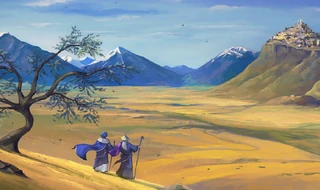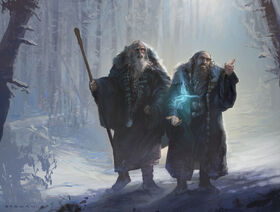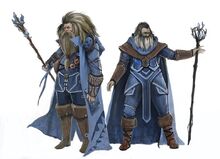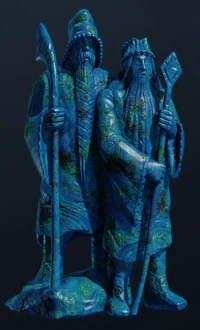- "Their task was to circumvent Sauron: to bring help to the few tribes of Men that had rebelled from Melkor-worship, to stir up rebellion... and after his first fall to search out his hiding and to cause dissension and disarray among the dark East... They must have had very great influence on the history of the Second Age and Third Age in weakening and disarraying the forces of the East... who both in the Second Age and Third Age otherwise have... outnumbered the West."
- —J.R.R. Tolkien
The Blue Wizards (or the Ithryn Luin) were two mysterious characters of Middle-earth, named as such because they both wore sea-blue robes.
History[]
- "I think that they went as emissaries to distant regions, east and south... Missionaries to enemy occupied lands as it were. What success they had I do not know; but I fear that they failed, as Saruman did, though doubtless in different ways; and I suspect they were founders or beginners of secret cults and "magic" traditions that outlasted the fall of Sauron."
- —J.R.R. Tolkien
The existence of five Wizards is only mentioned briefly in The Lord of the Rings. In J.R.R. Tolkien's Of the Rings of Power and the Third Age it is told that aside from Saruman, Gandalf, and Radagast, there were "others of the Istari who went into the east of Middle-earth, and do not come into these tales."[1] Tolkien also writes in Unfinished Tales that the two Wizards were sent to the East whose names were "Alatar" and "Pallando". Alatar was a Maia of the Vala Oromë who chose him to go to Middle-earth. Alatar asked his friend Pallando to join him on his mission.[2]

The Blue Wizards as seen by Ralph Damiani
The time that the Blue Wizards arrived in Middle-earth is uncertain. In Unfinished Tales, Tolkien wrote that the five Istari came to Middle-earth together in TA 1000. However, in The Peoples of Middle-earth, they are said to have arrived in the Second Age, around the year SA 1600, the time of the forging of the One Ring.[3] Their mission was directed at weakening Sauron's forces in the eastern and southern parts of Middle-earth, whereas the other Istari were focused on the west.
It is also uncertain whether they failed in their mission, but it seems most likely. In Unfinished Tales Tolkien writes that, "indeed of all the Istari, one only remained faithful," referring to Gandalf. Additionally, in letter 211, he said, "what success they had I do not know; but I fear that they failed, as Saruman did, though doubtless in different ways; I suspect that they were founders or beginners of secret cults and 'magic' traditions that outlasted the fall of Sauron".[4] However, in a text found in The Peoples of Middle-earth, alternate names are given: Morinehtar and Rómestámo (or Rome(n)star), which mean "Darkness-slayer" and "East-helper". It is unclear whether these names were intended as replacements for Alatar and Pallando, or merely alternatives.
The blue wizards succeeded in their another mission to stop the evil corruption done by the first and second dark lords in some groups of Easterlings and help them fight against those who have been corrupted. This civil war was the reason why the Easterling forces sent to aid Sauron were smaller than they should have been much larger.

The Blue Wizards journeying to the East
Etymology[]
The name Alatar probably means "after-comer", as he was one of the original two Maiar to be chosen to become Wizards and follow Sauron to Middle-earth. Tolkien specified that neither Alatar nor Pallando had a name in the west of Middle-earth, unlike the other Wizards.
Later in his life, Tolkien wrote a note suggesting that the names of the Blue Wizards were Morinehtar and Rómestámo. It is not clear whether these names were intended to replace the names Alatar and Pallando, or whether Morinehtar and Rómestámo were alternate names for the Blue Wizards, possibly those given to them by the peoples of Middle-earth.[5]
The name "Morinehtar" means "darkness-slayer." The name "Rómestámo" means "East-helper," from the Quenya word romen, meaning uprising, sunrise, east.
Appearances[]
Books[]
- The Lord of the Rings
- The Two Towers - Indirectly mentioned only

The two Blue Wizards Alatar and Pallando
- The Two Towers - Indirectly mentioned only
- The Silmarillion
- Of the Rings of Power and the Third Age - First mentioned
- Unfinished Tales
- The Istari - First appearance
Films[]
- The Lord of the Rings: The Return of the King - Extended edition; indirectly mentioned only
- The Hobbit: An Unexpected Journey - Mentioned only
Games[]
- Middle-earth: Shadow of Mordor - Mentioned only
In adaptations[]

Blue Wizards azurite figurine
Peter Jackson's The Hobbit trilogy[]
In The Hobbit: An Unexpected Journey, Gandalf is asked by Bilbo Baggins about the names of the blue wizards and replies "...I've quite forgotten their names." This is because the names "Alatar" and "Pallando" do not appear in The Lord of the Rings or The Hobbit books, and therefore the films did not have the rights to use them.
Peter Jackson's The Lord of the Rings trilogy[]
The Blue Wizards are never mentioned in The Lord of the Rings films, and are only referenced indirectly by Saruman, who mentions "the rods of the five wizards" in the extended edition of the third film.
Video games[]
In the game Middle-earth: Shadow of Mordor, a Weathered Azurite Figurine can be found in the north-western part of the Sea of Núrnen. In the game their names are not said, but the description of the artifact implies the two wizards are Alatar and Pallando. In the memory of this artifact is said:
"See, there were two of them, and they both came in from the road with a hard look in their eyes, as if they'd traveled too far and seen too much. They were Wizards, true, both of 'em caked in dust, and when one's talk he'd stop to think and there'd be the other to finish right up, like they had one brain and two mouths. It was creepy for sure, but neither seemed to notice. I heard them say they were hunting the darkness. Darned if I know if they found it. But I guess those fellows can find trouble when they're looking for it."
Translations[]
| Foreign Language | Translated name |
| Afrikaans | Blou Towenaars |
| Albanian | Magjistarët e Kaltër |
| Amharic | ሰማያዊ አጋዦች |
| Arabic | أزرق السحرة |
| Armenian | կապույտ Վիզարդզ |
| Azerbaijani | Mavi Sehrbazlar |
| Basque | Azti Urdinak |
| Belarusian Cyrillic | сінія чараўнікі |
| Bengali | নীল জাদুকররা |
| Bosnian | Plavi Čarobnjaci |
| Bulgarian Cyrillic | Сините Магьосници |
| Cambodian | អ្នកជំនួយការខៀវ |
| Catalan | Mags Blaus |
| Chinese (Hong Kong) | 藍色巫師 |
| Cornish | Pystrioryon Blou |
| Croatian | Plavi Čarobnjaci |
| Czech | Modří Čarodějové |
| Danish | Blå Troldmænd |
| Dutch | Blauwe Tovenaars |
| Esperanto | Bluaj Magiistoj |
| Estonian | Sinised Võlurid |
| Faroese | Bláur gandakallur ? |
| Fijian | Daucakamana ena Karakarawa |
| Filipino | Bughaw na Manggagaway |
| Finnish | Siniset Velhot |
| French | Mages Bleus |
| Frisian | Blau Tsjoender |
| Galician | Magos Azuis |
| Georgian | ლურჯი ჯადოსნები |
| German | Blaue Zauberer |
| Greek | Μπλε Μάγοι |
| Gujarati | બ્લુ વિઝાર્ડઝ |
| Haitian Creole | Sòsye Ble |
| Hawaiian | Uliuli Kupua |
| Hebrew | קוסמים הכחולים (Blue Wizards)
איתרין לואין (Ithryn Luin) |
| Hindi | ब्लू विजार्ड्स |
| Hungarian | Kék Varázsló |
| Icelandic | Blár Galdramenn |
| Indonesian | Penyihir Biru |
| Irish Gaelic | Draoi Gorm |
| Italian | Stregoni Blu |
| Japanese | 青のウィザード |
| Kannada | ನೀಲಿ ಮಾಂತ್ರಿಕರು |
| Kazakh | Көк сиқыршылар (Cyrillic) Kök sïqırşılar (Latin) |
| Korean | 청색의 마법사 |
| Kurdish | Sêrbazên Şîn (Kurmanji Kurdish) |
| Latin | Caeruleus Veneficus |
| Latvian | Zilie Burvji |
| Lithuanian | Mėlynos Burtininkai |
| Luxembourgish | Blo Zauberer |
| Macedonian Cyrillic | сина Визардс |
| Malagasy | Manga Mitsiatsiaka |
| Malaysian | Pendeta Biru |
| Maltese | Ikħal-sħaħar |
| Marathi | निळा विझार्ड्स |
| Mongolian Cyrillic | Цэнхэр ид шидтэнгүүд |
| Nederlands | Blauwe Tovenare |
| Nepalese | निलो जादूगर |
| Norwegian | Blå Veivisere |
| Occitan | Mascs Blau |
| Pashto | زنگالي جادوگران |
| Persian | جادوگران آبی (Blue Wizards)
ایترین لوین (Ithryn Luin) |
| Polish | Błękitni Czarodzieje |
| Portuguese | Magos Azuis |
| Punjabi | ਨੀਲੇ ਜਾਦੂਗਰ |
| Romanian | Vrăjitorii Albaștri |
| Russian | Синие маги |
| Sanskrit | नीलःमायाकार |
| Serbian | Плави Чаробњаци (Cyrillic) Plavi Čarobnjaci (Latin) |
| Sindhi | نيرو جادوگر |
| Sinhalese | නිල් සූනියම්කරුවන් |
| Slovak | Modrí čarodejníci |
| Slovenian | Modri Čarovniki |
| Somalian | Saaxiriinta Buluug |
| Spanish | Magos Azules |
| Swahili | Wachawi Bluu |
| Swedish | Blå Trollkarlar |
| Tajik Cyrillic | Кабуд ҷодугарон |
| Tamil | நீலம் சூனியக்காரர்கள் |
| Telugu | నీలము ఇంద్రజాలికులు |
| Thai | บลูวิซาร์ด |
| Turkish | Mavi Büyücüler |
| Ukrainian Cyrillic | Сині чарівники |
| Urdu | نیلا جادوگر |
| Uzbek | Кўк Сеҳргарлар (Cyrillic) Ko'k Sehrgarlar (Latin) |
| Vietnamese | Phù thủy Màu xanh |
| Welsh | Dewiniaid Glas |
| Yiddish | בלוי וויזאַרדס |
| Yucatec Maya | Magos Azules |
References[]
- ↑ The Silmarillion, Of the Rings of Power and the Third Age
- ↑ Unfinished Tales, Part Four, chapter II: "The Istari"
- ↑ Unfinished Tales, Part Four, chapter II: "The Istari"
- ↑ The Letters of J. R. R. Tolkien
- ↑ The History of Middle-earth, Vol. XII: The Peoples of Middle-earth, XIII: "Last Writings"
